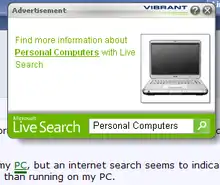In-text advertising
In-text advertising is a form of contextual advertising where specific keywords within the text of a web-page are matched with advertising and/or related information units.

Description
Although contextual advertising in general refers to the inclusion of advertisements adjacent to relevant online context (e.g., Google AdSense), in-text advertising places hyperlinks directly into the text of the webpage. In-text advertising is commonly available from In-Text Ad Networks like Kontera using technology such as IntelliTXT, or offered by publishers using Ad Serving technology from PowerLinks Media.
Advertising Model
In text advertising commonly works on a cost per click (CPC) model, which means that each time a website visitor clicks on an In-text ad, the websites owner gets paid by the advertiser. Other models include cost per impression (CPM), cost per action CPA and cost per play CPP for multimedia content ads (also known as Pay Per Play (PPP))
Criticism
The use of this type of advertising in news and journalism websites has been criticized by journalism ethics counselors as "ethically problematic at the least and potentially quite corrosive of journalistic quality and credibility."[1] However, publishers such as the Indianapolis Star who use in-text advertising have reported that despite early objections by some readers, such complaints have "tapered off".[2]
See also
References
- Is It News...or Is It an Ad? By David Kesmodal and Julia Angwin, Wall Street Journal November 27, 2006; Page R8
- Pitching Between the Lines by Catherine Holahan, BusinessWeek December 3, 2007